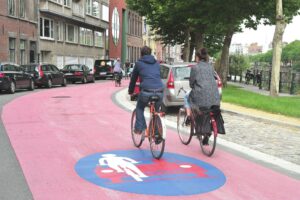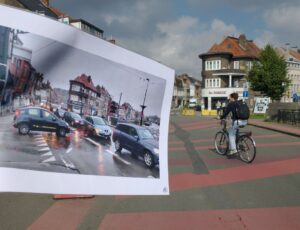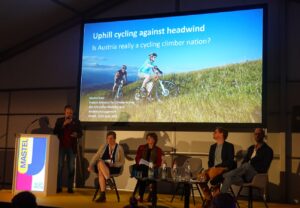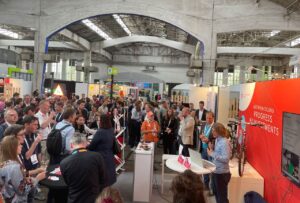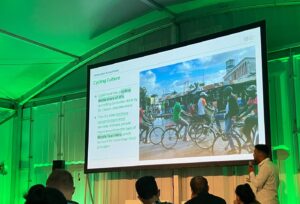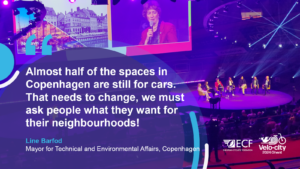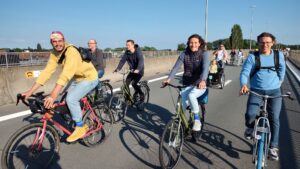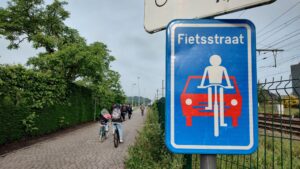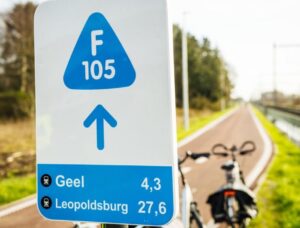This was the Velo-city conference 2024 in Ghent
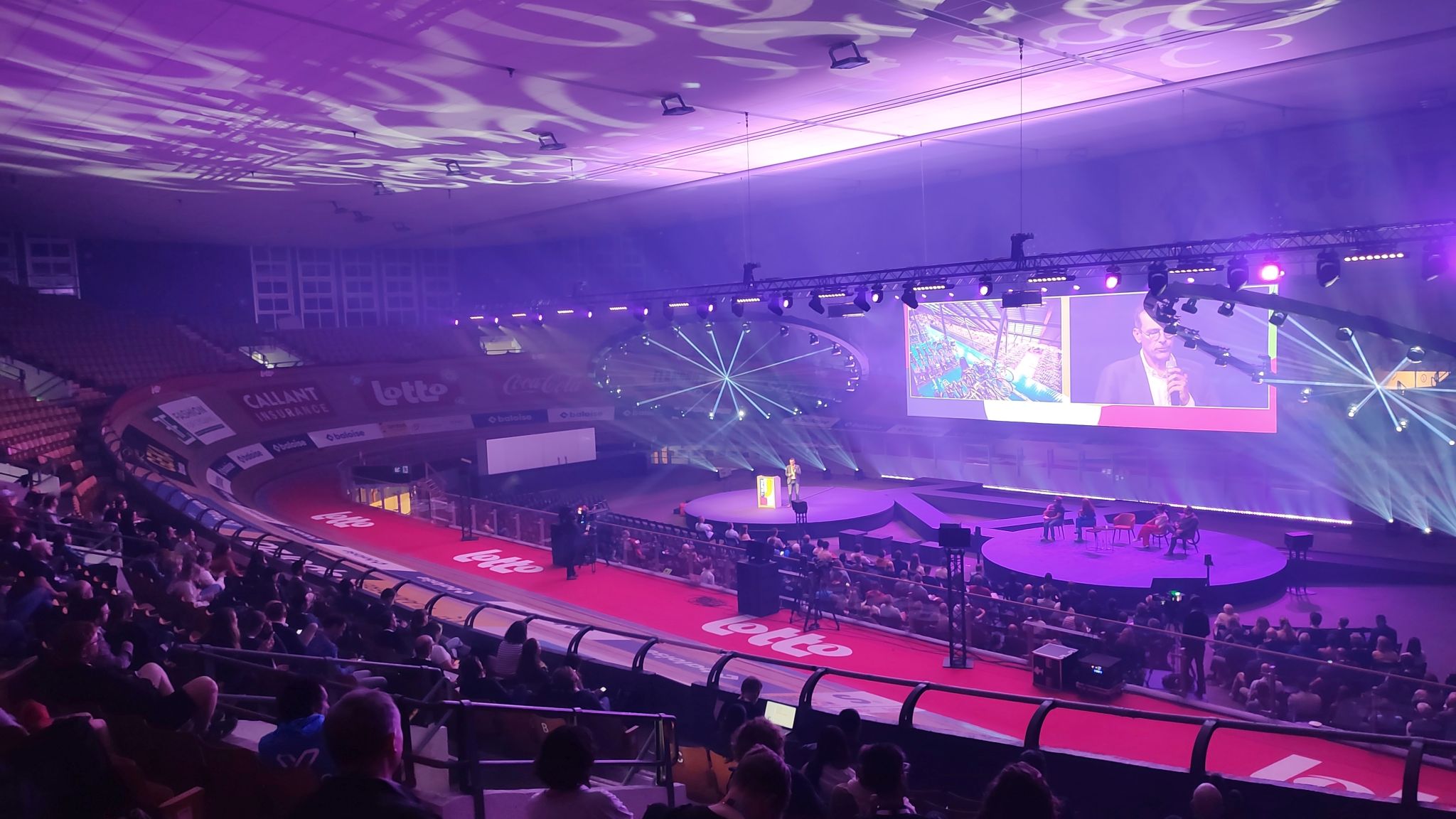
For 44 years, the Velo-city conference of the European Cyclists Federation has brought together the leading experts in cycling and has thus achieved the status of the world’s most important specialist conference. The largest edition to date took place from June 18 to 21 in Ghent, Belgium, with 1,650 participants. Cycle Competence Austria was prominently represented. We bring you highlights of the conference: lectures, cycling excursions, networking events and the annual cycling parade. The main hall of the event was the cycling track t’Kuipke, a worthy setting for lectures and panel discussions.
Traffic calming en masse: Gents Circulation Plan
One of the main protagonists of the conference was the city of Ghent itself: It has been able to attract attention in recent years in terms of traffic technology, particularly thanks to the “Circulation Plan” introduced in 2017. As part of this mobility plan, through traffic in the city center was severely restricted within the inner ring road with a diameter of three kilometers. The majority of roads were converted into bicycle lanes, bridge crossings were closed to motor vehicles, 21 surveillance cameras were installed and around 2,500 road signs were replaced over a weekend in April 2017.
At some intersections within the ring road, motor vehicle traffic has been reduced by over 90% as a result, and the busiest intersection sees over 3 million cyclists a year. After seven years, the bans on motor vehicle access with automated access control and the environmentally friendly traffic organization are also showing their success in the number of access violations: there are now only 11 per day in the entire inner city.
The before-and-after comparison during the conference excursion proves that where there was a traffic jam before the traffic calming measures, there is now a clear path for bicycles. The red road markings are part of temporary markings and furniture that have restricted the road space since 2017. Incidentally, the city council’s first Circulation Plan was implemented back in 1987, but was reversed due to political pressure. The bicycle plan followed in 1993 with the first bicycle lanes, in 1997 all pedestrian zones were connected to form a 25-hectare area, followed by a significant reduction in parking spaces in 2016. The traffic miracle of Ghent therefore has a long history and now has many imitators.
Austria’s presence at the conference
The Cycle Competence Austria platform, together with Cycle Competence supporting member klimaaktiv mobil, the initiative of the Ministry of Climate Protection (BMK), offered a varied program at the Austrian stand and on the lecture stages. Speakers included representatives from the BMK, the Vienna Mobility Agency, the University of Salzburg, Verracon and the Mobility Center Burgenland.
Colleagues from JobRad Austria, con.sens mobilitätsdesign, komobile, Radlobby, the City of Vienna, Boku Vienna, Move-It Graz and Wiener Linien were also on site. Cycle Competence member VELLO received a special presence with the raffle of a klimaaktiv mobil VELLO Alfine 11 folding bike as part of the City of Ghent’s Charity Game. You can read the entire program here.
The networking highlight of the conference expo was the traditional wine reception at the Cycle Competence stand, where insights into the transnational research project RADBEST, in which con.sens mobilitätsdesign, the University of Salzburg and Salzburg Research are playing a leading role, were provided for the first time. The results of the project will be published as an article in the fall!
International examples from Brazil to Mozambique
In addition to numerous presentations from Europe, the horizon was also broadened to other continents. Examples from the Global South also put the conference motto “Connecting through cycling” into geographical terms: In the Brazilian city of Fortaleza, the cycling network has been extended from 68 km to 400 km within the last eight years. The impetus for these improvements in cycling came about through the efforts of grassroots movements, which have worked together with the local population to make the necessity and benefits of cycling visible. There is now also a strong focus on bike sharing, which is free for public transport card holders in Fortaleza.
Quelimane in Mozambique is considered the city of bicycle cabs: the 35% share of bicycle traffic in the modal split is primarily based on the economic incentive of bicycle cabs. These are supported by the “association de bici cabs”. However, the aim is also to expand cycling for children and women by connecting more schools, markets and retirement homes with cycle paths.
Critical Mass Nairobi was given the opportunity to present the social benefits of cycling and joint cycling events in Kenya on the large stage of the Cycling Stadium.
Summary of four exciting conference days
The diverse presentations brought inspiring examples of cycling planning, strategies and transport policy to the five stages of the conference. Naturally, the focus was on successes and achievements – but there was also room for critical views on further challenges, such as here in the statement by Copenhagen’s city councillor for the environment. The team from Cycle Competence member con.sens mobilitätsdesign, some of whom travelled to the conference by bike, summed it up as follows: “Overall, the conference was excellently organized, the expert input was exciting and the culinary catering was varied. The exchange with so many cycling enthusiasts from Austria and other countries has once again motivated us to push ahead with the planning and design of consistent, safe and inclusive cycling infrastructure!”
Fietssnelwegen: Cycle highways in Flanders
Anyone interested in the constantly growing network of cycle highways in Flanders can find an overview of existing cycle highways and current projects on the fietssnelwegen.be website. An impressively dense network stretches across the region, with the design following the principle of using existing quiet traffic areas and railroad tracks and creating convenient connections via bridges and underpasses at key points. The consistent marking with the distinctive blue triangle and detailed orientation boards help users.
Photos: con.sens, Radvokaten, University of Salzburg, ECF, Fietssnelwege.be
Cycling Competence Members in this article:
BMK klimaaktiv mobil,con.sens,komobile,Radlobby Austria,VELLO,Verracon,Vienna Mobility Agency,Z-GIS Mobility Lab Uni Salzburg
More articles with this member:
[crp]
Share this article:
This was the Velo-city conference 2024 in Ghent
Share this article:

For 44 years, the Velo-city conference of the European Cyclists Federation has brought together the leading experts in cycling and has thus achieved the status of the world’s most important specialist conference. The largest edition to date took place from June 18 to 21 in Ghent, Belgium, with 1,650 participants. Cycle Competence Austria was prominently represented. We bring you highlights of the conference: lectures, cycling excursions, networking events and the annual cycling parade. The main hall of the event was the cycling track t’Kuipke, a worthy setting for lectures and panel discussions.
Traffic calming en masse: Gents Circulation Plan
One of the main protagonists of the conference was the city of Ghent itself: It has been able to attract attention in recent years in terms of traffic technology, particularly thanks to the “Circulation Plan” introduced in 2017. As part of this mobility plan, through traffic in the city center was severely restricted within the inner ring road with a diameter of three kilometers. The majority of roads were converted into bicycle lanes, bridge crossings were closed to motor vehicles, 21 surveillance cameras were installed and around 2,500 road signs were replaced over a weekend in April 2017.
At some intersections within the ring road, motor vehicle traffic has been reduced by over 90% as a result, and the busiest intersection sees over 3 million cyclists a year. After seven years, the bans on motor vehicle access with automated access control and the environmentally friendly traffic organization are also showing their success in the number of access violations: there are now only 11 per day in the entire inner city.
The before-and-after comparison during the conference excursion proves that where there was a traffic jam before the traffic calming measures, there is now a clear path for bicycles. The red road markings are part of temporary markings and furniture that have restricted the road space since 2017. Incidentally, the city council’s first Circulation Plan was implemented back in 1987, but was reversed due to political pressure. The bicycle plan followed in 1993 with the first bicycle lanes, in 1997 all pedestrian zones were connected to form a 25-hectare area, followed by a significant reduction in parking spaces in 2016. The traffic miracle of Ghent therefore has a long history and now has many imitators.
Austria’s presence at the conference
The Cycle Competence Austria platform, together with Cycle Competence supporting member klimaaktiv mobil, the initiative of the Ministry of Climate Protection (BMK), offered a varied program at the Austrian stand and on the lecture stages. Speakers included representatives from the BMK, the Vienna Mobility Agency, the University of Salzburg, Verracon and the Mobility Center Burgenland.
Colleagues from JobRad Austria, con.sens mobilitätsdesign, komobile, Radlobby, the City of Vienna, Boku Vienna, Move-It Graz and Wiener Linien were also on site. Cycle Competence member VELLO received a special presence with the raffle of a klimaaktiv mobil VELLO Alfine 11 folding bike as part of the City of Ghent’s Charity Game. You can read the entire program here.
The networking highlight of the conference expo was the traditional wine reception at the Cycle Competence stand, where insights into the transnational research project RADBEST, in which con.sens mobilitätsdesign, the University of Salzburg and Salzburg Research are playing a leading role, were provided for the first time. The results of the project will be published as an article in the fall!
International examples from Brazil to Mozambique
In addition to numerous presentations from Europe, the horizon was also broadened to other continents. Examples from the Global South also put the conference motto “Connecting through cycling” into geographical terms: In the Brazilian city of Fortaleza, the cycling network has been extended from 68 km to 400 km within the last eight years. The impetus for these improvements in cycling came about through the efforts of grassroots movements, which have worked together with the local population to make the necessity and benefits of cycling visible. There is now also a strong focus on bike sharing, which is free for public transport card holders in Fortaleza.
Quelimane in Mozambique is considered the city of bicycle cabs: the 35% share of bicycle traffic in the modal split is primarily based on the economic incentive of bicycle cabs. These are supported by the “association de bici cabs”. However, the aim is also to expand cycling for children and women by connecting more schools, markets and retirement homes with cycle paths.
Critical Mass Nairobi was given the opportunity to present the social benefits of cycling and joint cycling events in Kenya on the large stage of the Cycling Stadium.
Summary of four exciting conference days
The diverse presentations brought inspiring examples of cycling planning, strategies and transport policy to the five stages of the conference. Naturally, the focus was on successes and achievements – but there was also room for critical views on further challenges, such as here in the statement by Copenhagen’s city councillor for the environment. The team from Cycle Competence member con.sens mobilitätsdesign, some of whom travelled to the conference by bike, summed it up as follows: “Overall, the conference was excellently organized, the expert input was exciting and the culinary catering was varied. The exchange with so many cycling enthusiasts from Austria and other countries has once again motivated us to push ahead with the planning and design of consistent, safe and inclusive cycling infrastructure!”
Fietssnelwegen: Cycle highways in Flanders
Anyone interested in the constantly growing network of cycle highways in Flanders can find an overview of existing cycle highways and current projects on the fietssnelwegen.be website. An impressively dense network stretches across the region, with the design following the principle of using existing quiet traffic areas and railroad tracks and creating convenient connections via bridges and underpasses at key points. The consistent marking with the distinctive blue triangle and detailed orientation boards help users.
Photos: con.sens, Radvokaten, University of Salzburg, ECF, Fietssnelwege.be
Cycling Competence Members in this article:
BMK klimaaktiv mobil,con.sens,komobile,Radlobby Austria,VELLO,Verracon,Vienna Mobility Agency,Z-GIS Mobility Lab Uni Salzburg
More articles with this member:
[crp]

